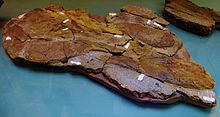I was scrolling through my feed and I discovered an extinct fish called Sacabambaspis, and I thought I should share some information I learned about it.

Description
Sacabambaspis was approximately 10 inches in length. The body shape of this unique fish vaguely resembled an oversized tadpole with a large head, flat body, wriggling tail, and lack of fins. It had funny looking, frontally positioned eyes, they even kind of looked like car headlights. I don’t think I have ever seen an animal with this unique of a face, especially on a fish.

Armor
Sacabambaspis had a large amount of armor on its head, which almost acted like a shield, it was made from a large upper plate that rose to a deep curved lower plate. This shield was ornamented with characteristic oak-leaf shaped or tear-drop shaped tubercles. It also had narrow branchial plates which linked along the sides and covered the gill area. The eyes were very far forward on its head and between them there might have been two nostrils and they might have been surrounded by a bone, which was found at the very front of the head, one of the characteristic features of the species. The rest of the body was covered by long, strap-like scales behind the head shield. However, I am not sure what this armor would protect from as it was less than a foot long, I think that this could have protected it from floating debris or from smaller parasites that lived in that time period.
Tail
The tail consisted of relatively large dorsal and ventral webs, the end of the tail was bordered by a small fin web. The tail structure was very unique, only being found in Sacabambaspis. I think that the tail of this fish is the most normal looking feature of it, although it is still quite unique.

Discovery
Sacabambaspis is named after the village of Sacabamba, Cochabamba Department, Bolivia, where the first fossils of the genus were found, there are 30 known specimens of this Bolivian species, all crammed into a very confined area and believed to be due to a sudden inflow of freshwater from a large storm. They were found with a large number of brachiopods, also killed at the same time. Scales found in Central Australia have a very similar ornamentation to the Bolivian scales, and Specimens have also been reported from Argentina. Evidently Sacabambaspis is quite a rare fish that there are not many fossils of. I think this could be that it was an easy prey for predators, as it was only 1 foot long.
Feeding
Although it had no jaws, the mouth of Sacabambaspis was lined with nearly 60 rows of small, bony, oral plates which were probably movable in order to provide a suction effect to suck in food.
Sensory System
The fossils of Sacabambaspis show clear evidence of a sensory structure. It was a line of pores within each of which were open nerve endings that could detect slight movements in the water, produced by predators or other fish. The arrangement of these organs allowed to detect the direction and distance from which a disturbance in the water was coming.
Conclusion
Tune into The Roundup for more scientific and zoologic findings from writers!
